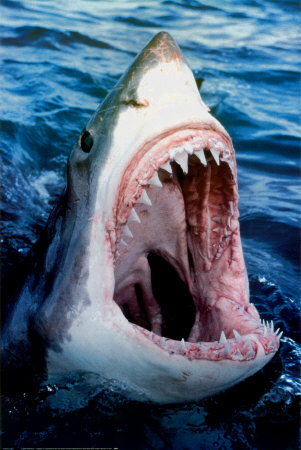Shark remains in Moyola tributary!
This amazing story, reveals that the small Altagoan river which meets the Moyola at the Milltown, [between Tobermore and Draperstown] is an important geological site, containing shark teeth.

The story is taken from the Habitas wesbite
"In the bed and banks of the Moyola River, around and extending about 1km downstream from its confluence with the Altagoan, a series of rocks are discontinuously exposed. They consist of mixed sediments, including sandstones, mudstones, muddy shales and a conglomerate containing carbonate pellets derived from soil.
The sequence is considerably disrupted by faulting, to such a degree that it is impossible to reconstruct the original order of the rocks. They are part of the Mormeal Member of the Altagoan Formation, part of the Chadian stage, about 350 million years old, and were formed on the equator in tropical conditions.
This short stretch of the Moyola River is famous because a rare occurrence of fish remains was described from here by one of the great pioneers of Irish geology, Captain R.J. Portlock, in his mammoth report of 1843 describing the geology of Londonderry and adjacent parts of Tyrone and Fermanagh. This material was assessed and used by Louis Agassiz in the first great compilation on the fossil fishes of the world, published between 1833 and 1844, and consequently the site was established as important by inclusion in this foundation work. The finds, however, were of isolated teeth, scales and fin spines and nothing approaching an entire fish was seen. Names were allocated but fish classification was in its infancy before 1850 and many of the identifications have since been challenged and are being restudied at the time of writing. Of more importance, following re-examination of one of Portlock’s specimens thought by him to be a jaw fragment from a fish, is its re-identification as a tetrapod jaw, probably an amphibian or reptile.
Tetrapods are rare and at this time enigmatic. There is no certainty that the specimen came from the Moyola (its documentation is incomplete) but the setting seems right and the site takes on new significance because of it. The environment in which these rocks were formed appears to have been an estuary with fresh and brackish water (there are few indicators of true marine life).
Further evidence of land close by is provided by frequent plant remains and fragments of scorpion cuticle (scorpions were some of the first colonizers of the land). Portlock also suggested that some plants were rooted and standing erect, implying the presence of soil. It seems very likely that this was the coastal fringe of the progressively encroaching early Carboniferous sea. This is one of the few localities yielding Carboniferous shark teeth in Northern Ireland and the only one marginal to land containing or associated with tetrapod remains.
In consequence, this stretch of the Moyola has considerable future research potential for the study of early Carboniferous coastal environments and in the search for early land vertebrates."

